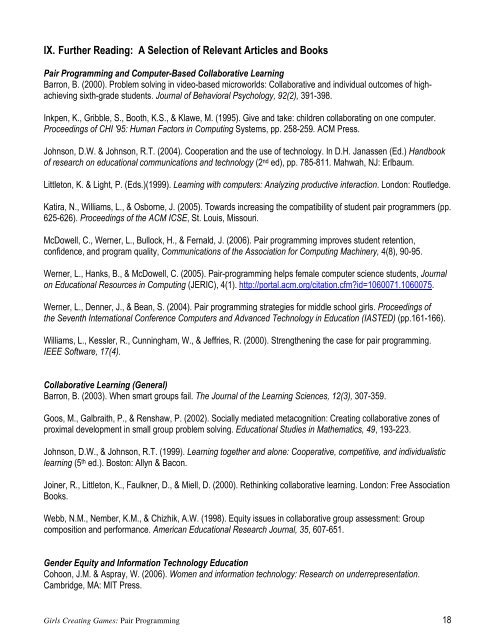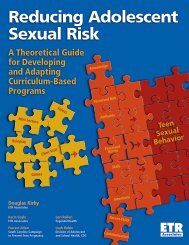Guide To Pair Programming - ETR Associates
Guide To Pair Programming - ETR Associates
Guide To Pair Programming - ETR Associates
Create successful ePaper yourself
Turn your PDF publications into a flip-book with our unique Google optimized e-Paper software.
IX. Further Reading: A Selection of Relevant Articles and Books<strong>Pair</strong> <strong>Programming</strong> and Computer-Based Collaborative LearningBarron, B. (2000). Problem solving in video-based microworlds: Collaborative and individual outcomes of highachievingsixth-grade students. Journal of Behavioral Psychology, 92(2), 391-398.Inkpen, K., Gribble, S., Booth, K.S., & Klawe, M. (1995). Give and take: children collaborating on one computer.Proceedings of CHI '95: Human Factors in Computing Systems, pp. 258-259. ACM Press.Johnson, D.W. & Johnson, R.T. (2004). Cooperation and the use of technology. In D.H. Janassen (Ed.) Handbookof research on educational communications and technology (2 nd ed), pp. 785-811. Mahwah, NJ: Erlbaum.Littleton, K. & Light, P. (Eds.)(1999). Learning with computers: Analyzing productive interaction. London: Routledge.Katira, N., Williams, L., & Osborne, J. (2005). <strong>To</strong>wards increasing the compatibility of student pair programmers (pp.625-626). Proceedings of the ACM ICSE, St. Louis, Missouri.McDowell, C., Werner, L., Bullock, H., & Fernald, J. (2006). <strong>Pair</strong> programming improves student retention,confidence, and program quality, Communications of the Association for Computing Machinery, 4(8), 90-95.Werner, L., Hanks, B., & McDowell, C. (2005). <strong>Pair</strong>-programming helps female computer science students, Journalon Educational Resources in Computing (JERIC), 4(1). http://portal.acm.org/citation.cfm?id=1060071.1060075.Werner, L., Denner, J., & Bean, S. (2004). <strong>Pair</strong> programming strategies for middle school girls. Proceedings ofthe Seventh International Conference Computers and Advanced Technology in Education (IASTED) (pp.161-166).Williams, L., Kessler, R., Cunningham, W., & Jeffries, R. (2000). Strengthening the case for pair programming.IEEE Software, 17(4).Collaborative Learning (General)Barron, B. (2003). When smart groups fail. The Journal of the Learning Sciences, 12(3), 307-359.Goos, M., Galbraith, P., & Renshaw, P. (2002). Socially mediated metacognition: Creating collaborative zones ofproximal development in small group problem solving. Educational Studies in Mathematics, 49, 193-223.Johnson, D.W., & Johnson, R.T. (1999). Learning together and alone: Cooperative, competitive, and individualisticlearning (5 th ed.). Boston: Allyn & Bacon.Joiner, R., Littleton, K., Faulkner, D., & Miell, D. (2000). Rethinking collaborative learning. London: Free AssociationBooks.Webb, N.M., Nember, K.M., & Chizhik, A.W. (1998). Equity issues in collaborative group assessment: Groupcomposition and performance. American Educational Research Journal, 35, 607-651.Gender Equity and Information Technology EducationCohoon, J.M. & Aspray, W. (2006). Women and information technology: Research on underrepresentation.Cambridge, MA: MIT Press.Girls Creating Games: <strong>Pair</strong> <strong>Programming</strong> 18
















